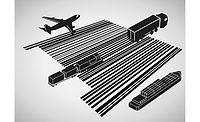Improving Food Safety Compliance with Digital Data Recording
-WAT106---Digital-data-recording-prevents-tampering-and-improves-food-safety-compliance.jpg?1704912941)
Image courtesy of Eurotherm
Recent decades have seen considerable advancements in food safety awareness, yet one in ten people still falls ill each year after eating contaminated food. Food manufacturers must stay compliant with modern safety legislation to tackle outbreaks. In this article, Thomas Slusser, North American CPG Account Manager at thermal solutions provider Watlow, explains how digital data recording helps food manufacturers comply with food safety regulations.
Each year, an estimated 600 million people globally fall ill because of contaminated food. Although many experience milder symptoms, such as nausea and dehydration, around 420,000 people die each year due to food poisoning. Some sufferers may also experience other health problems as a result, such as meningitis or kidney infections. These illnesses can persist even after the patient has recovered from the foodborne infection.
For food manufacturers, the consequences can be equally dire. According to one report, food safety incidents cost the U.S. economy around seven billion dollars annually. The economic impact comes from the costs of alerting customers, recalling contaminated products and paying damages.
Manufacturers may also suffer a loss of reputation, resulting in consumers being reluctant to buy their products. Additionally, foodborne pathogen outbreaks cause unscheduled downtime and decreased productivity for manufacturing plants as essential remedial measures are put in place.
The public health, financial, and legal implications of foodborne illnesses mean the importance of food safety cannot be overstated. To tackle the issue, food safety agencies are continually updating legislation and guidelines for manufacturers. As part of these regulations, food manufacturers must record their food handling processes. As the causes of foodborne illnesses are widespread, so are the measures put in place to reduce the likelihood of its occurrence.
One example is expired ingredients, which can cause food poisoning if spoiled or contaminated. For this reason, batches must be labeled with manufacture and expiration dates. However, across the industry, there are cases where critical processes and expiration dates have been changed to increase shelf life.
Tamper-Free Recording
To reduce the risks caused by such practices, the U.S. Food and Drug Administration (FDA) Food Safety Modernization Act (FSMA) contains a clause that states that files are stored in a format that cannot be tampered with.
This means paper charts, as well as some recording processes using digital programs that save data in a .csv format, may not be suitable. Although not all supervisory control and data acquisition (SCADA) systems, programmable logic controllers (PLCs) and basic data loggers save data in this format, it is important to check that the method used complies with storage regulations. Although the format allows for easy importing into spreadsheets, it is incapable of showing data alterations, meaning it cannot be used to demonstrate whether tampering has occurred.
To ensure compliance with the FSMA, food manufacturers should look for a data recorder or combination PLC offering a format that prevents data modification, such as binary check summed files. Some recorders, such as the 6000 Series range by Eurotherm—recently acquired by thermal solutions provider Watlow—allow data to be viewed only in software with tamper-resistant features. When changing configurations, operators may require a second level of authorization from a quality engineer depending on the alteration, with the changes being logged to increase process traceability.
In addition to reducing the likelihood of data tampering, modern data recorders also limit the potential for human error. With pen and paper, there is a higher chance that handwritten data could be misinterpreted, possibly even completely illegible. When it comes to food safety, the misreading of data could have negative consequences for product quality as well as for consumer health.
Accurate Temperature Testing and Recording
Moreover, modern data recorders offer higher levels of accuracy in temperature measurement than traditional recording methods.
This is key in food manufacturing because perishable products such as meat, fish and dairy must be kept at a temperature above 140°F (60°C) or below 40°F (4°C). Between 40°F (4°C) and 140°F (60°C), also known as the ‘danger zone’, bacteria multiply rapidly, increasing the growth of foodborne pathogens. The FDA requires food manufacturers to use accurate and reliable temperature measurement devices, which must be calibrated regularly.
Equally important is that manufacturers can prove that product temperatures were maintained within this acceptable range and provide traceability in the event that temperatures fall outside limits. To this end, the FDA requires that food manufacturers maintain records of food temperatures, and these records must be accurate, reliable and accessible to authorized personnel.
The U.S. FDA 21 CFR Part 11, Electronic Records; Electronic Signatures guidance establishes the requirements for using electronic records and signatures in the regulated food industry. Further, this section of 21CFRPt11 requires system validation, audit trails, electronic signatures and most importantly, security. Food manufacturers must implement security measures to protect their electronic records and signatures from unauthorized access, modification, or destruction.
However, if communication is interrupted while data is being transferred from the recorder to other software, like historians or MES, this can cause data loss. As a result, manufacturers may be unable to prove that the batch has remained within critical temperature limits. Eurotherm products record data at the point of measurement and automatically backfill missing data, utilizing a distinctive technology called Store & Forward, reducing the likelihood of data loss and enabling manufacturers to comply with FDA regulations. Eurotherm was the first to introduce this novel 21CFRPt11 compliant, self-healing data feature.
Increased Competitive Advantage
Although the FDA is only responsible for U.S. food regulation, investing in equipment that aids compliance with strict safety standards is beneficial to food manufacturers across the globe.
According to the U.S. Department of Agriculture (USDA), the total value of food imports into the U.S. has increased every year since 2009, and in 2022 equaled almost $200 billion. For overseas food manufacturers looking to enter this growing market, compliance with FSMA standards gives them a competitive advantage.
Improved Sustainability Practices
Digital data recorders also ensure that food and beverage manufacturers can track their progress in line with climate pledges. Although numerous major producers have committed to achieving net zero emissions, recent data shows that many manufacturers have made no progress against their goals. At the same time, some have increased their emission levels.
Modern data recorders help manufacturers track and achieve these targets by using the data generated by smart energy meters, probes and sensors. Recorders can then document and perform calculations with this data, creating valuable insights for food and beverage producers looking to increase sustainability within their processes. Likewise, for U.S. food manufacturers with European subsidiaries, digital data recorders ensure they comply with necessary sustainability regulations.
For example, the UK’s Energy Savings Opportunity Scheme (ESOS) requires qualifying large companies to carry out audits of the energy consumed by manufacturing plants, processes and transport every four years. As the scheme also requires manufacturers to determine energy-saving measures, the calculations from digital data recorders allow managers to create strategies to reduce energy consumption.
Investing in a digital data recorder also furthers process sustainability as it eliminates the need for pen and paper. As the files used in Eurotherm recorders can be compressed, this increases the amount of data that can be stored while eliminating the waste that is generated by pen and paper.
As food safety regulations continue to be modernized, it is essential for the benefit of both manufacturers and consumers that requirements are met. Investing in modern digital data recorders allows food manufacturers to comply with regulations while increasing competitive advantage and sustainability, both now and in the future.
Looking for a reprint of this article?
From high-res PDFs to custom plaques, order your copy today!
WAT106---Thomas-Slusser-headshot.jpg?height=96&t=1705503868&width=96)






